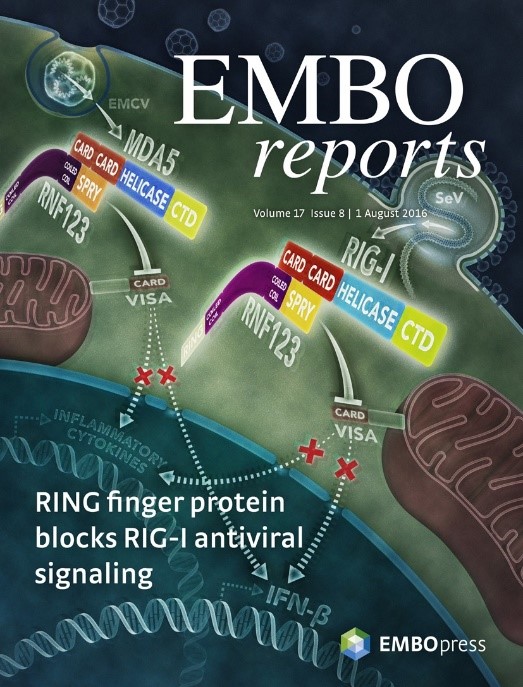EMBO Reports:北京大学陈丹英研究组揭示RNA病毒识别受体负调控机制
2016年8月1日,欧洲分子生物学杂志《EMBO Reports》杂志上在线发表了北京大学生命科学学院陈丹英研究组题为“An E3 ligase-independent function for RNF123 in RIG-I like receptors-mediated antiviral signaling”的研究论文,论文当选本期《EMBO Reports》杂志封面论文。博士研究生王帅为该研究论文的第一作者,陈丹英副教授为通讯作者。
RNA病毒是脊椎动物主要的病原体之一。RIG-I/MDA5广泛表达于各种类型细胞,负责识别入侵的病毒RNA,启动信号转导,活化干扰素和炎症因子的表达,产生抗病毒效应。
RING蛋白家族成员RNF123曾被报道作为细胞周期调控蛋白p27的E3泛素连接酶,负责泛素化修饰p27介导其降解,从而促进细胞周期。细胞水平的敲低和敲除实验证明,人RNF123(hRNF123)能够特异性抑制RNA病毒诱导的I型干扰素及炎症因子表达,这一功能与hRNF123的泛素酶活性及泛素酶协同因子均不相关。RNA病毒刺激诱导hRNF123与病毒识别受体RIG-I/MDA5特异结构域的结合,从而阻抑它们与下游接头蛋白VISA形成复合物传递信号。在小鼠细胞中,mRNF123不具有类似功能。该研究发现了病毒识别受体RIG-I/MDA5新的调控因子,提示了泛素连接酶发挥功能的新方式,以及人鼠细胞天然免疫调控存在不同。

原文链接:
RNF123 has an E3 ligase‐independent function in RIG‐I‐like receptor‐mediated antiviral signaling
原文摘要:
Retinoic acid‐inducible gene I (RIG‐I) and melanoma differentiation‐associated gene 5 (MDA5) are cytoplasmic sensors crucial for recognizing different species of viral RNAs, which triggers the production of type I interferons (IFNs) and inflammatory cytokines. Here, we identify RING finger protein 123 (RNF123) as a negative regulator of RIG‐I and MDA5. Overexpression of RNF123 inhibits IFN‐β production triggered by Sendai virus (SeV) and encephalomyocarditis picornavirus (EMCV). Knockdown or knockout of endogenous RNF123 potentiates IFN‐β production triggered by SeV and EMCV, but not by the sensor of DNA viruses cGAS. RNF123 associates with RIG‐I and MDA5 in both endogenous and exogenous cases in a viral infection‐inducible manner. The SPRY and coiled‐coil, but not the RING, domains of RNF123 are required for the inhibitory function. RNF123 interacts with the N‐terminal CARD domains of RIG‐I/MDA5 and competes with the downstream adaptor VISA/MAVS/IPS‐1/Cardif for RIG‐I/MDA5 CARD binding. These findings suggest that RNF123 functions as a novel inhibitor of innate antiviral signaling mediated by RIG‐I and MDA5, a function that does not depend on its E3 ligase activity.
作者:陈丹英

